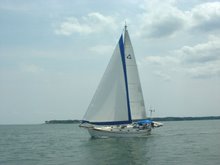In the 1860s Mormon pioneers from Utah brought cattle to the area, and a large cattle ranching operation was established. In 1866, after Indian raids, a protective fort was constructed over the main spring. Anson Perry Winsor was sent by the Mormons to operate the ranch and maintain the fort, which was soon thereafter known as "Winsor Castle". This isolated outpost served as a way station for people traveling across the state and as a "tithing cattle" ranch. It also served as a refuge for polygamist wives during the 1880s and 1890s.
Unfortunately, while affording protection to the white settlers, the fort also prevented the local Kaibab Paiutes from using the spring water that they'd depended on for many generations. Although their way of life was greatly impacted by the Mormon settlement, the surviving Kaibab continued to eke out a living in the area and in 1907 the Kaibab Paiute Indian Reservation was established, surrounding the privately owned Pipe Spring ranch. In 1923, the Pipe Spring ranch was purchased and set aside as a national monument to be a memorial of Kaibab and pioneer life in the area. A deal was negotiated between the Kaibab, the National Park Service, and the local ranchers to share the output of the spring equally.
We were treated to an amazing pre-sunset
And an even more amazingly colourful sunset
Recently, the International Dark Sky Association (http://darksky.org/), issued a press release naming the Kaibab Paiute Reservation as its first Dark Sky Nation. According to the press release, “never before has an entire group of ethnically and linguistically related people come together to collectively embrace dark-skies principles. As a result of the Kaibab Band of Paiute Indians’ work to protect the pristine night skies over its northern Arizona territory, IDA is pleased to announce the designation of the Kaibab Paiute Indian Reservation as an International Dark Sky Community. The IDA status makes the Kaibab Paiute truly the world’s first dark sky nation.”
We were lucky enough to be there for the Kaibab band's inaugural Dark Sky celebration. Complete with tribal leaders and singers, amateur astronomers, and the Bryce Canyon National Park Service's "Star Lab" inflatable planetarium, the event was a big success. We even walked to and from our campsite under the light of the stars without a flashlight. We had a wonderful time.
Blooming Prickly Pear cactus
The next morning, we took the park rangers up on their generous offer of the day before and harvested corn, carrots, yellow, hard, and zucchini squashes, green beans, and a jalapeno pepper from the monument's garden. What a score!!












